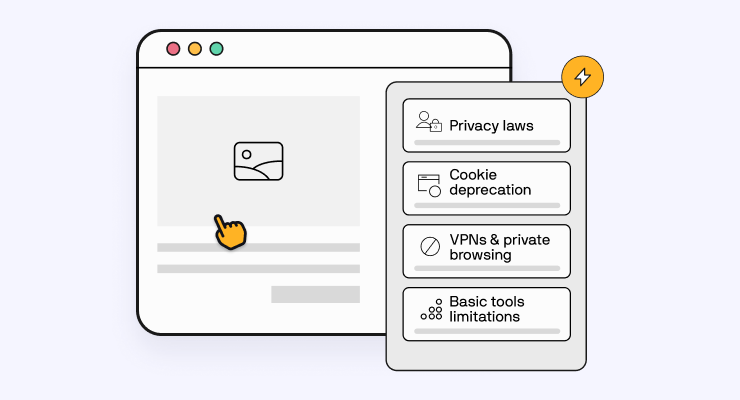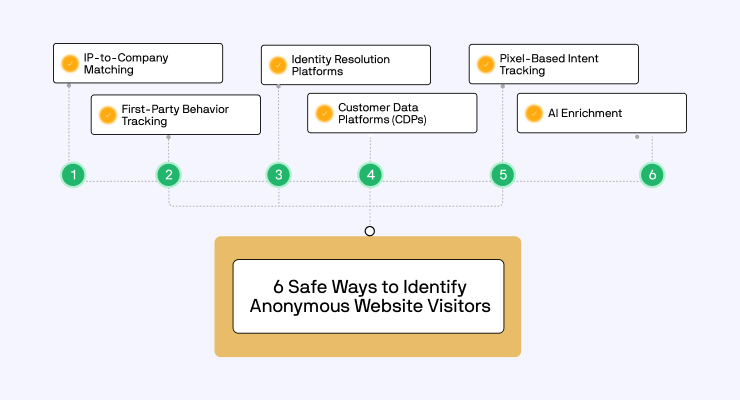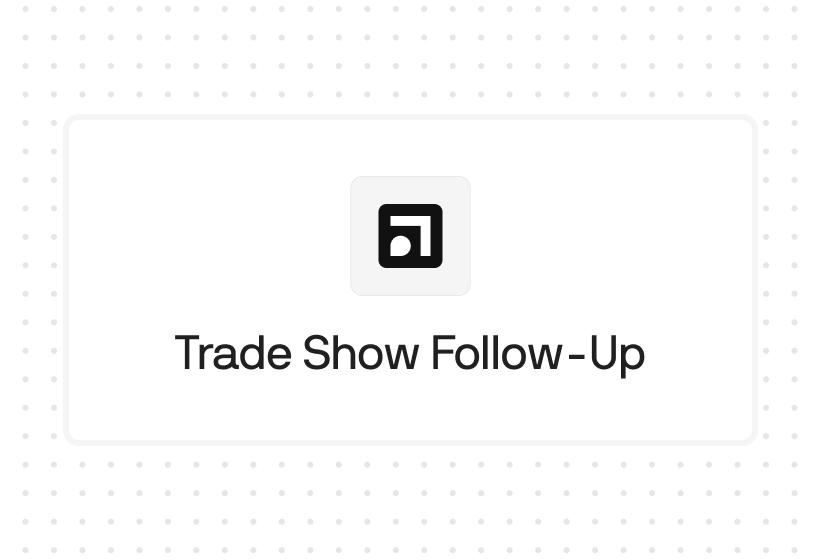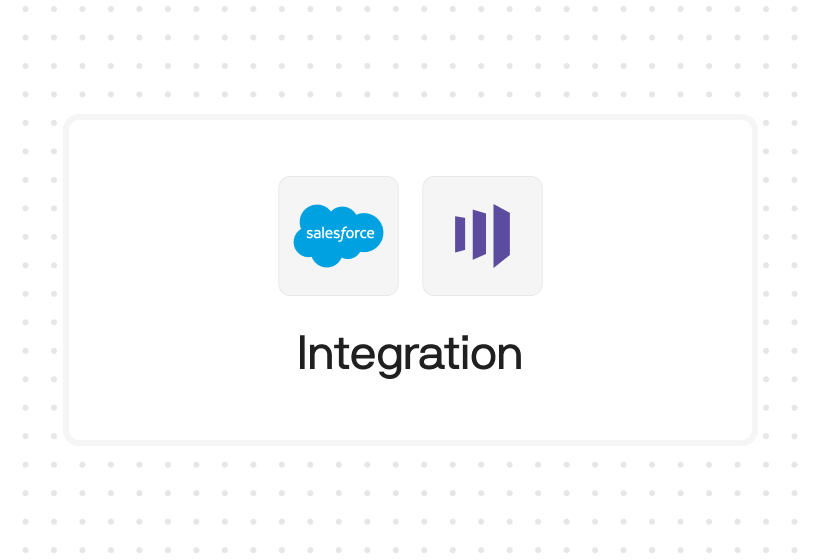Try Default

See how revenue teams automate revenue operations with Default.

Key Takeaways
Key takeaways
- Up to 98% of your website traffic is anonymous—largely due to privacy laws, cookie restrictions, and incognito browsing. Traditional tools can’t tell you who’s visiting or why it matters.
- Identifying anonymous visitors is possible—and legal—when you combine modern techniques like IP resolution, behavioral analytics, identity graphs, CDPs, and AI-powered enrichment.
- The business impact is real: faster sales outreach, smarter ABM campaigns, better lead scoring, proactive churn prevention, and fraud detection—all without relying on personal data.
- Legacy tracking tools fall short in today’s B2B environment. They miss intent signals, buying committee behavior, and cross-device journeys—leaving revenue on the table.
- Default turns anonymous traffic into pipeline, automatically enriching and routing high-intent visits
You can’t close deals with traffic—you need contacts.
The problem? Up to 98% of your website visitors stay anonymous. No names. No emails. Just bounce rates and vague metrics. That’s hundreds (or thousands) of missed opportunities every week.
But here’s the upside: if you can identify those anonymous visitors—legally and accurately—you unlock a goldmine for sales and marketing.
Think: account-level insights for ABM, enriched firmographics for retargeting, and real-time alerts when high-intent buyers visit your pricing page.
In this guide, you’ll learn how to turn anonymous website traffic into qualified pipeline—without relying on cookies, guesswork, or outdated tools.
Let’s get started.
Why 98% of your traffic stays anonymous—and what that means for pipeline
Most of your traffic is invisible by design.
Between GDPR, CCPA, cookie deprecation, VPNs, and private browsing, the average visitor leaves little trace behind. And with tools like Google Analytics showing you aggregated trends—not identities—it’s no wonder so much of your audience slips through unnoticed.
This isn’t a tracking failure. It’s the new baseline.
To identify who’s behind the click, you need to go beyond cookies and standard analytics. That starts by understanding why anonymity is now the default—and what that means for your lead generation strategy.

The revenue case for identifying anonymous website visitors
In B2B, most buying journeys start long before a contact form gets filled.
That anonymous traffic? It often includes decision-makers from target accounts, comparing vendors, researching use cases, or checking out pricing. If you’re not identifying them, you’re giving your competitors a head start.
When done right, anonymous visitor identification unlocks real, measurable value:
- Sales teams can prioritize outbound to warm accounts already showing intent.
- Marketing can tailor campaigns and retarget based on industry, company size, or behavior.
- Customer success teams can detect churn risks early—or spot expansion opportunities.
- Even fraud prevention teams can flag suspicious patterns before damage is done.
It’s not about spying, it’s about connecting the dots between interest and action, while staying compliant.
6 proven, privacy-safe ways to identify anonymous visitors
Most tracking tools weren’t built for today’s privacy-first environment. That’s why leading B2B teams are shifting away from outdated methods and combining smarter, compliant techniques that uncover intent without crossing the line. Here’s how modern B2B teams are doing it.

IP resolution and firmographic enrichment
By matching a visitor’s IP address to known company networks, platforms like Clearbit Reveal or Leadfeeder can identify which companies are browsing your site—even if no one fills out a form.
When you enrich that data with firmographics like industry, employee count, and revenue, it becomes a sales and marketing goldmine. Teams can immediately flag high-fit accounts, trigger personalized ad sequences, or fast-track outbound sequences to companies already showing interest.
First-party behavioral analytics
Tools like Heap, Plausible, or PostHog allow you to track how visitors move through your site—what they click, how long they stay, and which paths they follow. This data builds a picture of intent, not identity. For example, a user visiting your pricing page three times in a week without converting is likely deeper in the funnel than a casual blog reader.
Behavioral data helps you segment anonymous traffic by buying stage and feed more tailored campaigns or product-led growth strategies.
Identity resolution platforms
Platforms like 6sense, Demandbase, and ZoomInfo combine behavioral signals, IP lookups, and identity graphs to make probabilistic matches between anonymous visits and known company profiles.
It’s not about naming individuals—it’s about surfacing which accounts are active in the buying cycle. That means sales can reach out while interest is hot, and marketing can align messaging based on real-time behavior, not just firmographic guesswork.
Customer data platforms (CDPs)
A CDP stitches together first-party data from across your stack—website activity, CRM, email engagement, product usage—into persistent visitor profiles. Even without personally identifiable information (PII), these profiles grow smarter over time.
This gives your team the ability to recognize returning users, deliver more relevant content, and orchestrate cross-channel journeys that feel personalized from the first touch.
Pixel-based intent tracking
By adding tracking pixels to key conversion points—like your demo request or pricing page—you can monitor repeat activity from the same session or company.
When those signals are connected to IP or behavioral patterns, you get a clear picture of which companies are warming up to buy. It’s a powerful way to prioritize outreach and retargeting to the most engaged accounts.
AI-powered enrichment tools
Modern tools use machine learning to infer anonymous visitor details based on context—browser type, referral source, behavior pattern, time on site. Alone, these signals may seem generic. But trained AI enrichment tools can recognize patterns that correlate with company size, buyer role, or purchase intent. It’s an emerging but increasingly effective way to fill in the blanks where traditional methods fall short—without ever capturing PII.
When combined, these techniques don’t just reveal who’s visiting—they tell you who’s ready to buy, how to reach them, and how to move faster than your competition.
Where traditional tracking fails—and why your funnel suffers for it
Your analytics tools might be telling you what happened, but not who did it, or why it matters.
And that’s a problem in B2B. You’re not selling sneakers—you’re tracking buying committees across weeks-long journeys, multiple channels, and shifting decision-makers. Yet most legacy tracking methods were built for one-and-done conversions, not high-consideration deals.
Here’s where traditional approaches consistently break down:
1. Google Analytics can’t connect activity to real buyers
It’s a traffic monitor, not a sales engine. While you’ll see broad engagement trends, you won’t know which companies visited your pricing page or how often target accounts returned. It gives you volume, but no actionable context.
Top tip: Before implementing any ID solution, make sure you’ve excluded internal IPs, agencies, and partners from your tracking. Otherwise, you risk chasing signals from your own team—skewing attribution models and contaminating pipeline reporting.
2. CRM tracking is tied to form submissions
Most CRMs only start collecting meaningful data after a visitor identifies themselves—usually by filling out a form, clicking an email, or logging into your app. That means you're missing critical pre-conversion signals: which pages they visited, how often they returned, and whether they showed buying intent earlier. By the time someone shows up as a lead, your chance to influence their journey may already be gone.
3. Cookies are unreliable and disappearing
Third-party cookies are being phased out across Chrome, Safari, and Firefox. Even first-party cookies are affected by ad blockers and tracking prevention settings. The result? Inconsistent attribution, broken user paths, and retargeting efforts that miss the mark.
4. Attribution across devices and sessions is broken
Modern B2B buyers move between work laptops, phones, and personal devices. Most tracking tools can’t stitch those sessions together, meaning the full journey—from discovery to decision—is fragmented and incomplete.
5. No visibility into buying committees
One visitor might browse case studies, while another on the same team checks pricing. Traditional tools treat these as unrelated users instead of a collective signal from an account. That’s a huge miss when selling to multiple stakeholders.
6. Data silos between tools
Google Analytics, your CRM, your ad platform—they all collect data, but rarely talk to each other. That fragmentation means valuable signals get lost between systems, reducing your ability to act in real time.
7. Lagging insights, not live intelligence
Most traditional tracking is batch-processed and delayed. By the time your sales team sees engagement data, the moment to act may be gone. You’re not just missing data—you’re missing momentum.
Here’s a side-by-side snapshot of where legacy tools fall short:
The takeaway? Traditional tools still serve a purpose—but they can’t power growth on their own. If you’re serious about revenue intelligence, you need systems that show who is engaging, how, and when to act.
5 high-impact use cases across sales, marketing, and CS
Identifying anonymous visitors isn’t just a data play, it drives measurable outcomes across the entire revenue team. Here’s how companies are turning previously invisible traffic into tangible impact.
Accelerating outbound with real-time account alerts
Sales teams use account-level identification to detect when a target company visits high-intent pages, like pricing or solution comparisons. Combined with firmographic enrichment, this enables reps to prioritize outreach while interest is fresh, personalizing messages based on what the account engaged with.
Powering account-based marketing (ABM) with behavioral triggers
Marketers use anonymous visitor behavior to trigger account-based workflows: launching targeted ads, surfacing industry-specific content, or escalating warm accounts to SDRs. Rather than waiting for form fills, campaigns activate based on real-time buyer activity.
Enhancing lead scoring with pre-conversion intent signals
By layering behavioral data into scoring models, companies can identify which anonymous users are most likely to convert. That means cleaner pipeline, better handoff between marketing and sales, and less wasted effort on low-intent leads.
Top tip: Use behavioral signals (e.g. repeated pricing page visits, time spent on solution pages) to tag accounts by buying stage. Combine identity + intent to separate window-shoppers from decision-makers before passing anything to sales.
Identifying churn and expansion signals in product-led growth
In SaaS and PLG models, visitor identification helps CS teams detect patterns tied to churn risk (e.g. frequent visits to help docs) or expansion potential (e.g. admins viewing pricing tiers). It turns passive traffic into proactive account management.
Preventing fraud and account misuse
Security and fraud prevention teams use identity resolution to detect unusual access patterns—like frequent visits from IPs tied to flagged networks, or account activity outside expected geographies—without relying on personal data.
Top tip: Integrate anonymous visitor data directly into your CRM or BI tool and build a ‘ghost’ dashboard of high-fit, high-intent accounts that haven’t converted. Yet. This gives sales leadership visibility into real demand that isn’t reflected in pipeline reports.
Together, these use cases show what anonymous visitor identification really delivers: leverage. Not just more data, but better timing, sharper targeting, and faster decisions across your go-to-market teams.
Turn anonymous traffic into revenue—with Default
Default doesn’t just show you who’s on your site—it turns anonymous visits into pipeline, automatically.
- Surface high-intent accounts in real time
Default’s pixel identifies visiting companies the moment they land, enriches them with firmographic data, and routes alerts straight to sales—no form fill required. - Engage faster with automated enrichment and routing
Every visit is auto-enriched with CRM data, website intel, and contact details, then pushed to your team via Slack or CRM. No digging. No delays. Just context-rich visibility and instant prioritization. - Use AI agents to do the heavy lifting
Default’s AI scrapes company sites, reviews CRM history, and compiles actionable profiles, so your reps don’t waste time researching or qualifying. - Drive real revenue impact
Teams using Default see up to 67% faster speed-to-lead, cut misrouted leads by 5×, and lift inbound conversions by 17%. That’s anonymous traffic, activated.
Default brings identification, enrichment, and action into a single, automated flow—built to turn hidden demand into closed revenue.
Get started
Book an interactive demo to see how Default reveals and routes your invisible traffic.
Or check out the case studies to see how companies like Bland unlocked new pipeline in weeks.
Conclusion

Former pro Olympic athlete turned growth marketer! Previously worked at Chili Piper and co-founded my own company before joining Default two years ago.
Accelerate your growth with Default.
Revamp inbound with easier routing, actionable intent, and faster scheduling















.png)








%201.svg)



.svg)





%201.svg)



%201.svg)

